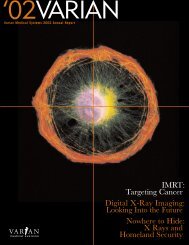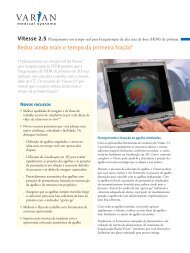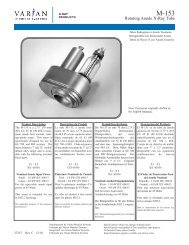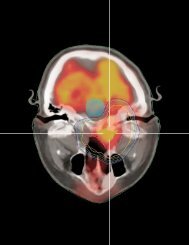Varian Linatron High-Energy X-ray Applications 2007
Varian Linatron High-Energy X-ray Applications 2007
Varian Linatron High-Energy X-ray Applications 2007
Create successful ePaper yourself
Turn your PDF publications into a flip-book with our unique Google optimized e-Paper software.
Characteristics of <strong>High</strong>-<strong>Energy</strong> Radiation<br />
Advantages of <strong>High</strong>-<strong>Energy</strong> X-Rays<br />
The high energy x-<strong>ray</strong>s produced by <strong>Linatron</strong>s provide a<br />
number of advantages over traditional x-<strong>ray</strong> radiography.<br />
These include:<br />
• Making the radiography of very thick sections<br />
economically feasible.<br />
• Making it possible to achieve large source-toobject/object-to-film<br />
distance (D/T) ratios to<br />
minimize object distortion.<br />
• Allowing short exposure times for high<br />
throughput rates.<br />
• Combining high film latitude with reduced<br />
scatter allowing high detail resolution in<br />
radiographs of large complex assemblies.<br />
• Making it possible to use slower fine-grained X<strong>ray</strong><br />
film and real time radiography systems.<br />
Generation of <strong>High</strong> <strong>Energy</strong> X-Rays<br />
Electrons are injected at moderately high energies into a<br />
tuned resonant waveguide structure and accelerated<br />
toward a target by high electric fields. When these<br />
electrons strike the target, they rapidly decelerate. This<br />
deceleration creates high-energy bremsstrahlung X-<strong>ray</strong><br />
spectrum. The spectrum is characteristic of the target<br />
material, the target design, and the energy spectrum of<br />
the incident electron beam. The same process takes place<br />
in conventional X-<strong>ray</strong> equipment, but the higher energy<br />
<strong>Linatron</strong> electron beam produces a higher efficiency<br />
conversion of electrons into X-<strong>ray</strong>s.<br />
Measurement of <strong>High</strong> <strong>Energy</strong> X-Rays<br />
The “Roentgen” is the standard unit of measure for x-<strong>ray</strong>s,<br />
which quantifies exposure to a source of ionizing radiation.<br />
“Exposure”* is fundamentally a property of the beam<br />
rather than a measure of the effect of the beam on the<br />
object to be irradiated. The basic quantity that<br />
characterizes the energy imparted to matter by ionizing<br />
particles is the absorbed dose. The unit of absorbed dose is<br />
page 5<br />
the G<strong>ray</strong>, often abbreviated “Gy”**. Gy is defined as the<br />
amount of energy imparted to matter per unit mass of<br />
irradiated material and is equal to 1 joule per kilogram.<br />
In practice, the radiation output of a <strong>Linatron</strong> is measured<br />
by first measuring exposure, the charge produced by the x<strong>ray</strong><br />
beam in a given volume of air using an ionization<br />
chamber dosimeter. Correction factors are then used to<br />
calculate the absorbed dose in a material. Ion chamber<br />
measurements are normally made at a given depth in a<br />
water phantom or with the ion chamber surrounded by a<br />
plastic cylinder or equilibrium cap in order to achieve<br />
electronic equilibrium. For low-atomic-number materials,<br />
a Roentgen measured in air is approximately equivalent to<br />
one rad of absorbed dose. <strong>Linatron</strong> outputs are described<br />
in units of Gy per minute at one meter.<br />
*The term “exposure” is used primarily to describe the fact that<br />
film has received X-<strong>ray</strong> radiation during radiography of an<br />
object under test in subsequent sections of this manual.<br />
Exposure refers to the effect of the X-<strong>ray</strong> beam on the film in<br />
this context.<br />
**This manual uses Gy values for absorbed energy dose values.<br />
1 Gy (G<strong>ray</strong>) = 100 rad.<br />
Target Characteristics<br />
The target is a component in the <strong>Linatron</strong>, which absorbs<br />
high energy electrons and produces x-<strong>ray</strong>s. The intensity<br />
of the X-<strong>ray</strong>s produced at the target is a function of the<br />
electron beam intensity and the X-<strong>ray</strong> production<br />
efficiency of the target. Target efficiency is defined as the<br />
ratio of the total X-<strong>ray</strong> radiation power produced to the<br />
total power of the impinging electron beam. This<br />
efficiency depends on both target composition and<br />
geometry. The most efficient targets are made of materials<br />
with a high atomic number (high Z elements). Tungsten<br />
(Z=74) offers the best combined efficiency and physical<br />
properties. This is the primary material used in the<br />
<strong>Linatron</strong> target. It has a thickness slightly greater than the<br />
range of the electrons in the target material.<br />
<strong>Varian</strong> <strong>Linatron</strong> applications


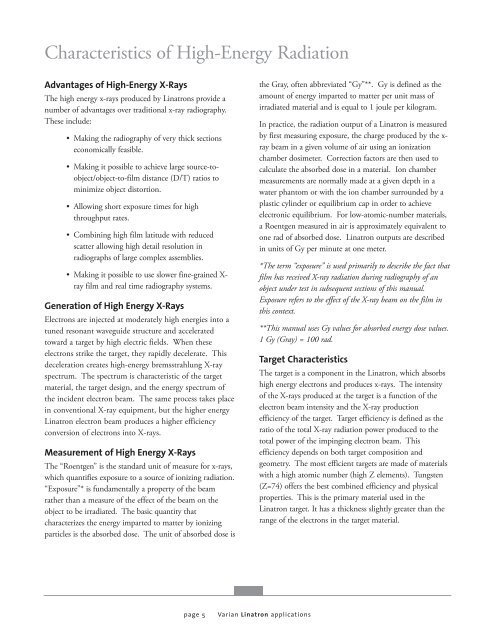






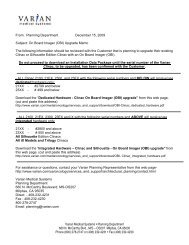
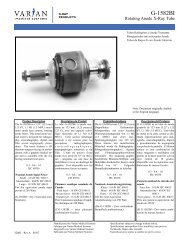
![[MSDS 126] Dow Corning 200 Fluid, 5 CST Part Number ... - Varian](https://img.yumpu.com/5104917/1/190x245/msds-126-dow-corning-200-fluid-5-cst-part-number-varian.jpg?quality=85)

